Special Report
The Most Highly-Decorated US Navy Ships of WWII
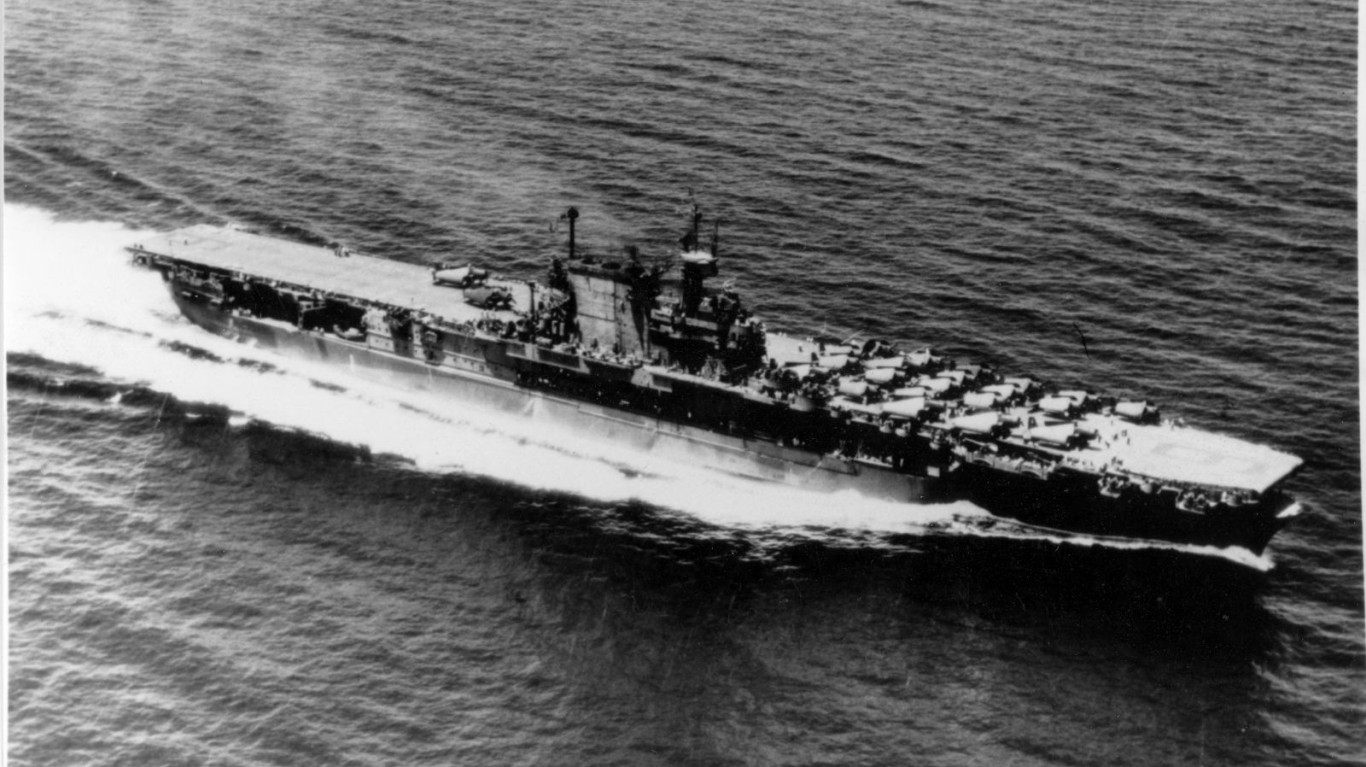
Published:
Last Updated:

The United States showcased an impressive naval fleet in WWII. Among the numerous ships that served during the war, a select few stood out as the most decorated, earning battle stars for their accomplishments. (See the most mass produced U.S. naval ships in WWII.)
Battle stars are awards and recognition given to naval vessels for their active involvement and meritorious performance in a specific naval engagement, battle, or even campaign. As these stars add up, these vessels gain more prestige having survived and succeeded in multiple conflicts.
To determine the most decorated ships of World War II, 24/7 Wall St. referenced Official Military Ribbons, an online database of WWII ships and their decorations. We ranked the ships according to how many battle stars each received over the course of the war, excluding any ship with less than 15 battle stars. These battle stars convey how many conflicts each ship has survived, with more battle stars meaning more prestige. We included supplemental information about each ship’s type, class, year entered service, and personnel from various military and historical stories.
The undisputed champion in terms of battle stars earned during WWII is the USS Enterprise (CV-6), which boasts an impressive 20 battle stars. Launched in October 1936, the USS Enterprise contributed to many significant battle campaigns in the Pacific theater. This vessel earned accolades for its action during the Battle of Midway, the Battle of the Santa Cruz Islands, and the Guadalcanal Campaign. Due to its significant role in providing air support, the USS Enterprise contributed immensely to the United States’ victory in the Pacific.
Next in line, the USS San Francisco (CA-38), a New Orleans-class heavy cruiser, received 17 battle stars during its service in WWII. This vessel saw action in some of the most significant campaigns and battle engagements in the Pacific Theater. Key engagements included the battles of Cape Esperance, Wake Island, and the Guadalcanal Campaign. (Conversely, these are famous U.S. ships that were sunk in WWII.)
The USS Enterprise and USS San Francisco are only two of the most decorated U.S. military ships of WWII. With the backing of the rest of the fleet, these vessels played a vital role in achieving victory in the Pacific and an ultimate conclusion to the war through their gallantry and meritorious performance. Here’s a look at the most decorated U.S. warships from WWII.
Click here to see the most highly-decorated US ships of WWII.
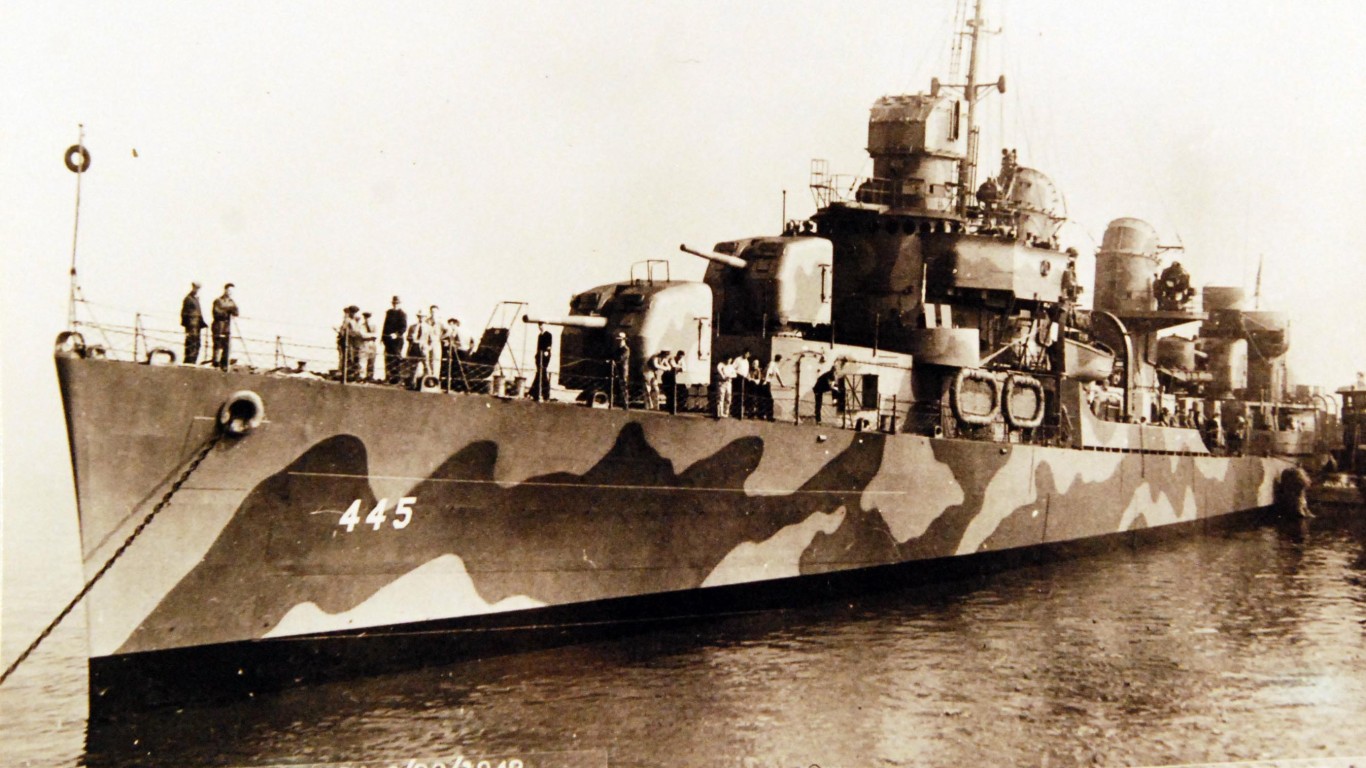
15. USS Fletcher (DD-445)
> WWII battle stars: 15 (tied)
> Type: Destroyer
> Class: Fletcher-class
> Year entered service: 1942
> Personnel: 273
USS Fletcher, which entered service in 1942, played a crucial role in the Guadalcanal Campaign and other significant actions of WWII. Stationed near New Caledonia, it carried out active patrolling and escort duties, participating in key actions in the Solomon Islands and the Philippines. The Fletcher effectively engaged and sank or destroyed multiple enemy warships, submarines, and aircraft.
After undergoing an overhaul, the destroyer was decommissioned in 1947 but recommissioned in 1949 as an anti-submarine warfare platform. The ship was finally decommissioned in 1969.
[in-text-ad]

14. USS San Diego (CL-53)
> WWII battle stars: 15 (tied)
> Type: Light cruiser
> Class: Atlanta-class
> Year entered service: 1942
> Personnel: 796
USS San Diego was the third of eight Atlanta-class light cruisers, designed to protect carriers with anti-aircraft guns and torpedoes, as opposed to previous destroyer classes, which were designed primarily for ship and shore bombardment. San Diego played a vital role in several major campaigns of the war, seeing action in notable naval battles such as the Naval Battle of Guadalcanal and the assault on Okinawa. The ship also served as an escort for aircraft carriers, including the USS Hornet and the USS Enterprise. San Diego’s active service came to an end when it was decommissioned in July 1946.
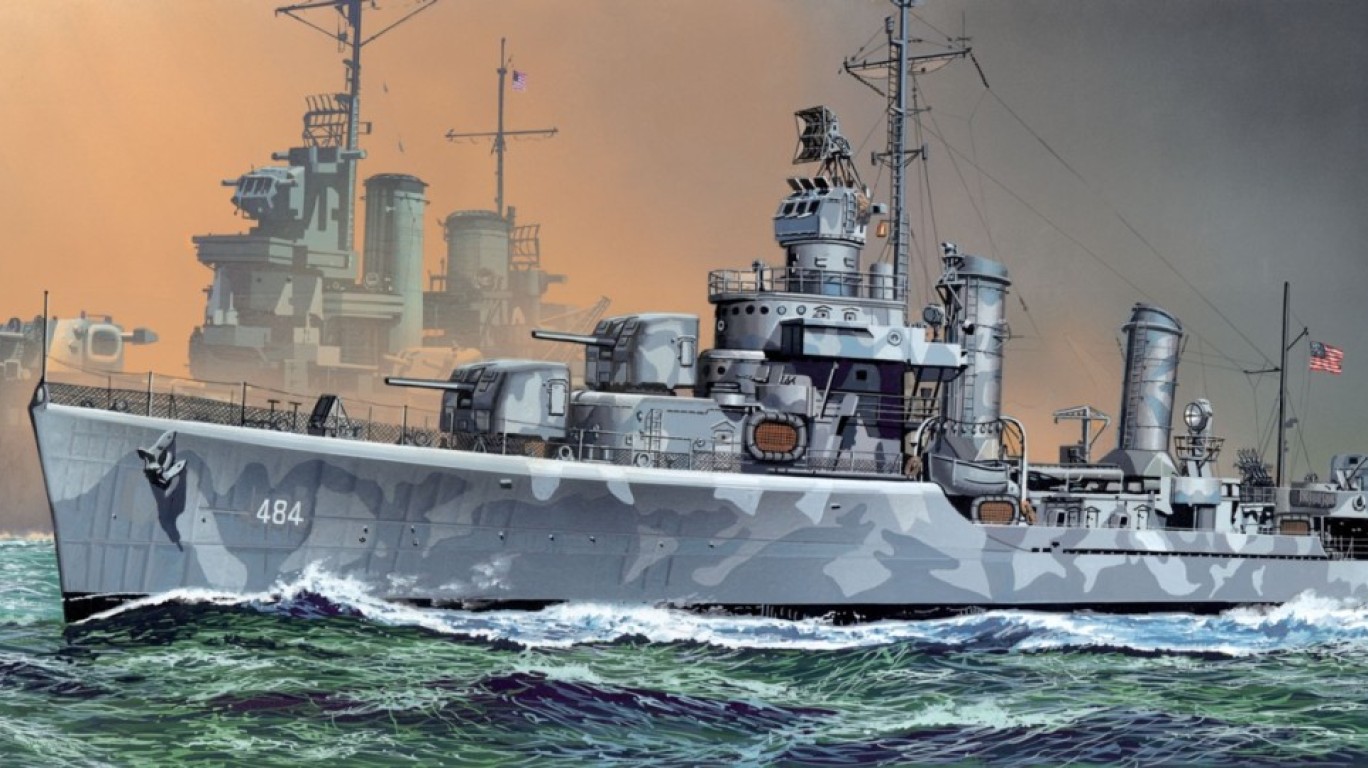
13. USS Buchanan (DD-484)
> WWII battle stars: 15 (tied)
> Type: Destroyer
> Class: Gleaves-class
> Year entered service: 1941
> Personnel: 212
The USS Buchanan, a Gleaves-class destroyer, was armed with four single mount 5-inch guns, one set of four 1.1-inch anti-aircraft cannons, five 20mm Oerlikon guns, and five 21-inch torpedo tubes, along with depth charges for anti-submarine warfare.
The ship played a vital role in the Guadalcanal and Tulagi landings in August 1942, rescuing survivors of sunken ships during the Battle of Savo Island. Buchanan also participated in the Battle of Cape Esperance in October, but suffered damage during the Naval Battle of Guadalcanal in November. After repairs, the ship engaged in convoy escort duty until February 1943. The ship sank the Japanese submarine RO-37 in January 1944 and later underwent overhaul at Mare Island, later seeing action in Palau, Luzon, Iwo Jima, and Okinawa. After serving as an escort to Fleet Admirals Nimitz and Halsey, Buchanan remained in the Far East until being decommissioned in May 1946.
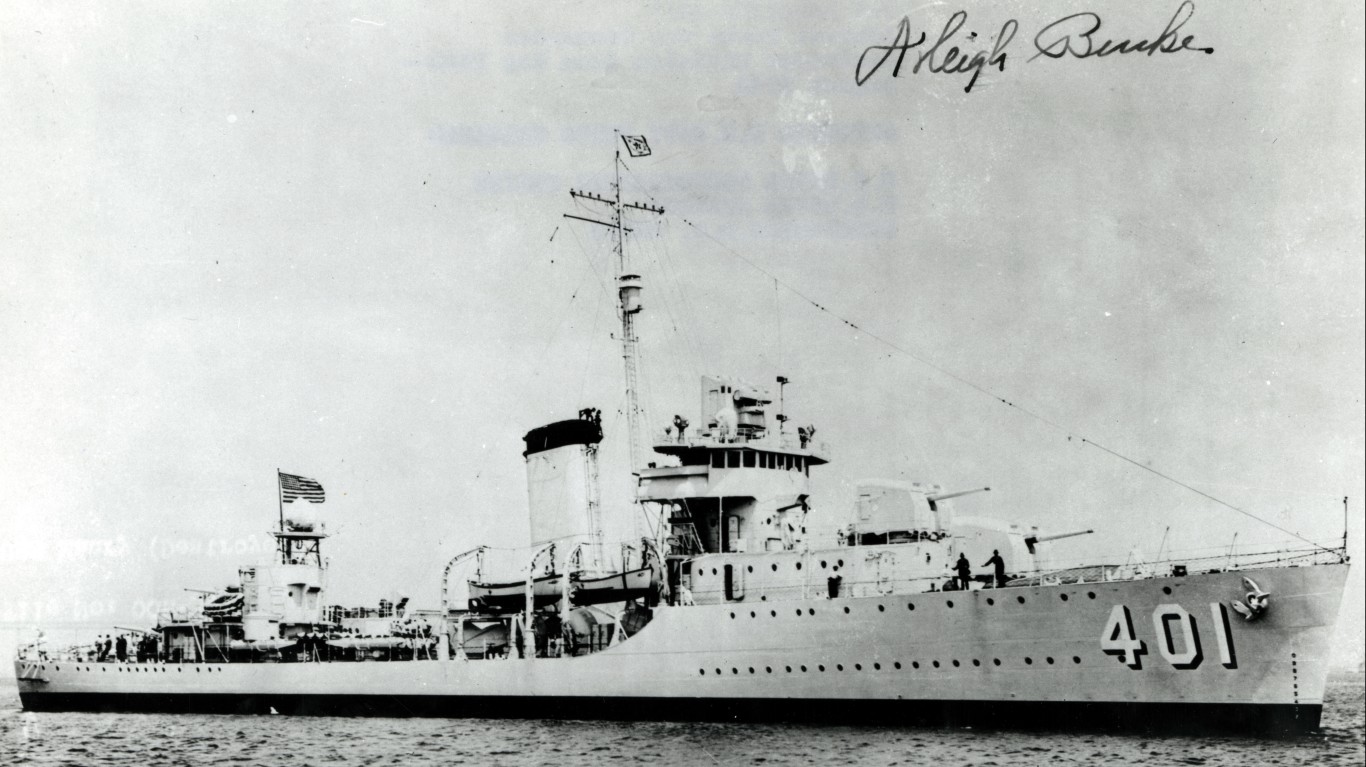
12. USS Maury (DD-401)
> WWII battle stars: 16 (tied)
> Type: Destroyer
> Class: Gridley-class
> Year entered service: 1936
> Personnel: 176
The USS Maury entered service in 1936 and was out escorting the carrier USS Enterprise during the Pearl Harbor attacks. During the war, Maury participated in many engagements and campaigns across the Pacific, including the Battle of Midway, the invasion of Guadalcanal and Tulagi, the Battle of the Eastern Solomons, and the Battle of the Santa Cruz Islands.
During the Battle of Tassafaronga, Maury was part of a force that surprised Japanese destroyers, leaving the battle unscathed. The destroyer continued to serve in the Solomons, participating in the taking of the Gilberts and Marshalls invasions, the Battle of the Philippine Sea, and the Battle of Leyte Gulf. Maury’s service earned it 16 battle stars and the Presidential Unit Citation.
[in-text-ad-2]
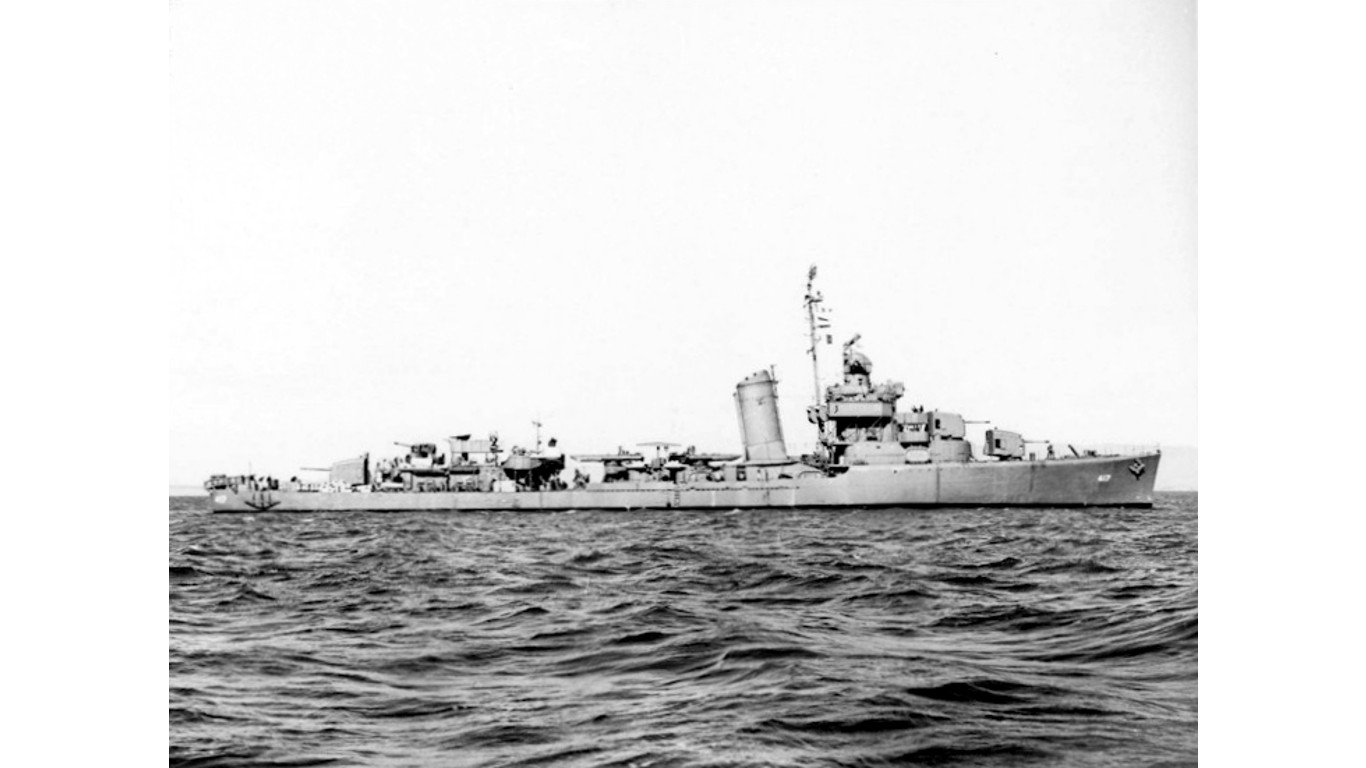
11. USS Morris (DD-417)
> WWII battle stars: 16 (tied)
> Type: Destroyer
> Class: Sims-class
> Year entered service: 1940
> Personnel: 192
Commissioned in 1940, the Morris served in the North Atlantic Patrol, facing the constant threat of German submarines and battleships. After the outbreak of hostilities, the ship was equipped with the first fire control radar on a destroyer. In the Pacific, the Morris participated in the Battle of the Coral Sea, rescuing survivors from the sinking USS Lexington, which earned its commander the Navy Cross. The ship also played a role in the Battle of Midway, once again rescuing survivors.
The Morris supported landing operations on Guadalcanal and took part in numerous campaigns in the Pacific, including the Marshall Islands, New Guinea, and Okinawa. Despite being hit by a kamikaze during the Battle of Okinawa, the crew’s efforts saved the ship.

10. USS Nicholas (DD-449)
> WWII battle stars: 16 (tied)
> Type: Destroyer
> Class: Fletcher-class
> Year entered service: 1942
> Personnel: 336
The destroyer USS Nicholas (DD-449) escorted troop and supply convoys to Guadalcanal, screened convoys, and conducted anti-submarine missions. The ship participated in major engagements during the war, including the Battle of Kula Gulf, for which the ship was awarded the Presidential Unit Citation and the Battle of Kolombangara.
The Nicholas also provided fire support, conducted bombardments, and supported landings in different areas. It played a crucial role in the liberation of various islands, including Luzon and Tarakan. After the war, the USS Nicholas participated in repatriation of prisoners of war. The ship would go on to serve in the Korean and Vietnam Wars.
[in-text-ad]

9. USS Russell (DD-414)
> WWII battle stars: 16 (tied)
> Type: Destroyer
> Class: Sims-class
> Year entered service: 1938
> Personnel: 192
Commissioned in November 1939, the destroyer USS Russell initially served on neutrality patrols in the western Atlantic and Caribbean. However, after the bombing of Pearl Harbor, Russell was sent to the Pacific Theater. It participated in numerous operations and battles, including the Battle of the Coral Sea, the Battle of Midway, and the Guadalcanal campaign.
The Russell provided screening and escort duties for aircraft carriers, protected troop transports, engaged in naval gunfire support, and conducted submarine patrols. It also played a role in the invasions of the Gilbert Islands, the Marshall Islands, the Philippines, and Okinawa. The destroyer was decommissioned in November 1945 and later sold for scrap in 1947.
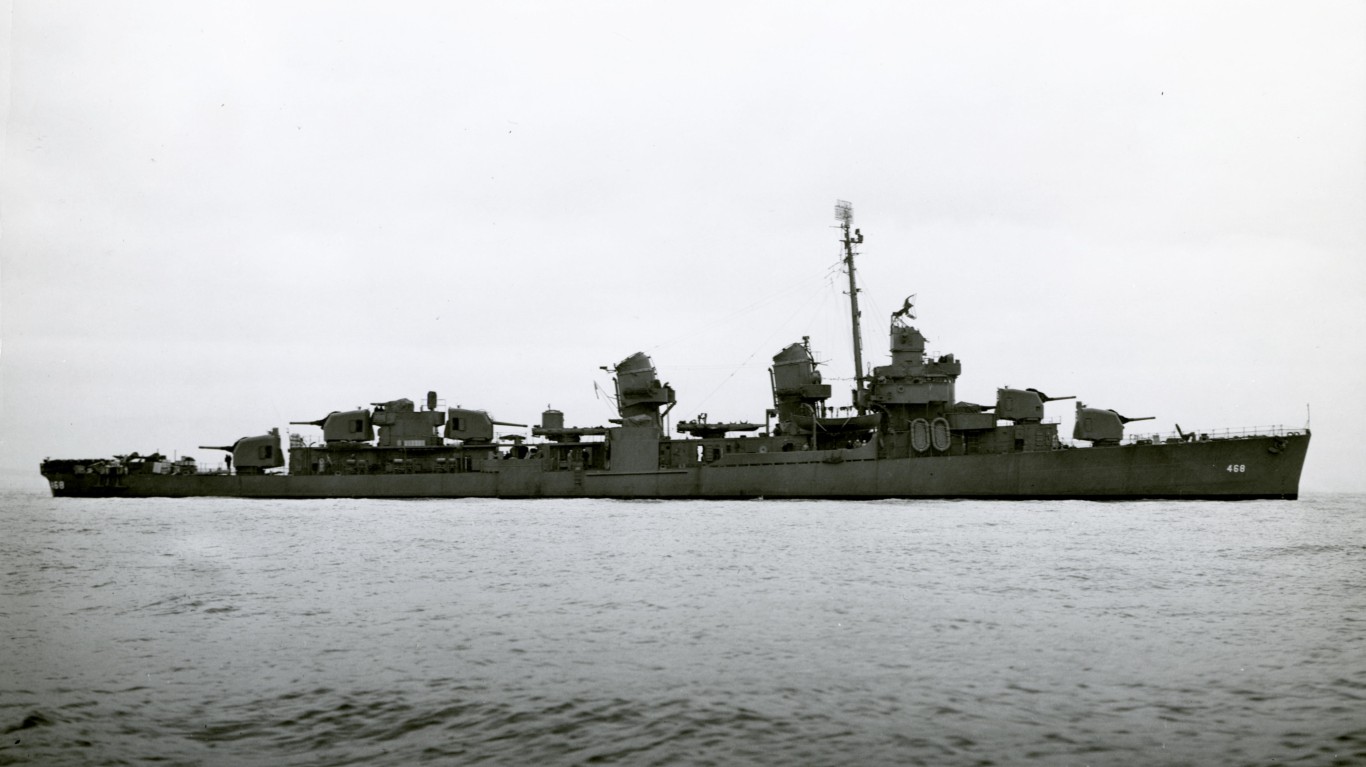
8. USS Taylor (DD-468)
> WWII battle stars: 16 (tied)
> Type: Destroyer
> Class: Fletcher-class
> Year entered service: 1942
> Personnel: 336
Commissioned in August 1942, the USS Taylor began its career with the Atlantic Fleet and was assigned to Destroyer Squadron 20, performing convoy escort duty along the coast until November 1942, then escorted a transatlantic convoy to Casablanca.
In January 1943, the ship was transferred to the Pacific theater and participated in various operations there, engaging in battles, conducting patrols, and providing escort cover for troop transports and carriers. The Taylor received a special commendation for outstanding heroism during the Solomons Campaign from March to October 1943. It later took part in the Gilbert Islands campaign and participated in raids on the Marshall Islands.

7. USS New Orleans (CA-32)
> WWII battle stars: 16 (tied)
> Type: Heavy cruiser
> Class: New Orleans-class
> Year entered service: 1934
> Personnel: 915
After surviving the Japanese attack on Pearl Harbor with minor damage, this heavily decorated heavy cruiser began its career in the second world war. As the lead ship of the New Orleans class, the vessel was part of a group of seven cruisers, with three lost during the war and four surviving until retirement.
Notable battles the USS New Orleans engaged in included the Battle of Coral Sea, Battle of Midway, Battle of the Eastern Solomons, and the Battle of Tassafaronga, during which it suffered severe damage. The ship’s last wartime actions involved supporting the amphibious landings at Okinawa. Following the war, the USS New Orleans served in various capacities before being decommissioned in 1947.
[in-text-ad-2]

6. USS Portland (CA-33)
> WWII battle stars: 16 (tied)
> Type: Heavy cruiser
> Class: Portland-class
> Year entered service: 1933
> Personnel: 848
The lead ship of the class of cruisers bearing its name, the USS Portland served alongside its infamous sister ship, the USS Indianapolis — known for sinking after delivering parts for the Hiroshima atom bomb and the all-time greatest loss of life for a single U.S. Navy Ship. Commissioned in 1933, the Portland was initially classified as a light cruiser but was later reclassified as a heavy cruiser. Portland was involved in a number of significant battles such as the Battle of Coral Sea, the Battle of Midway, and the Guadalcanal Campaign.
Despite suffering damage from an enemy torpedo at Guadalcanal, the ship underwent repairs and stayed in the war. USS Portland’s final actions involved supporting the Allied landings at Okinawa and participating in Operation Magic Carpet to bring veterans home. The ship was decommissioned in 1946 and sold for scrap in 1959.
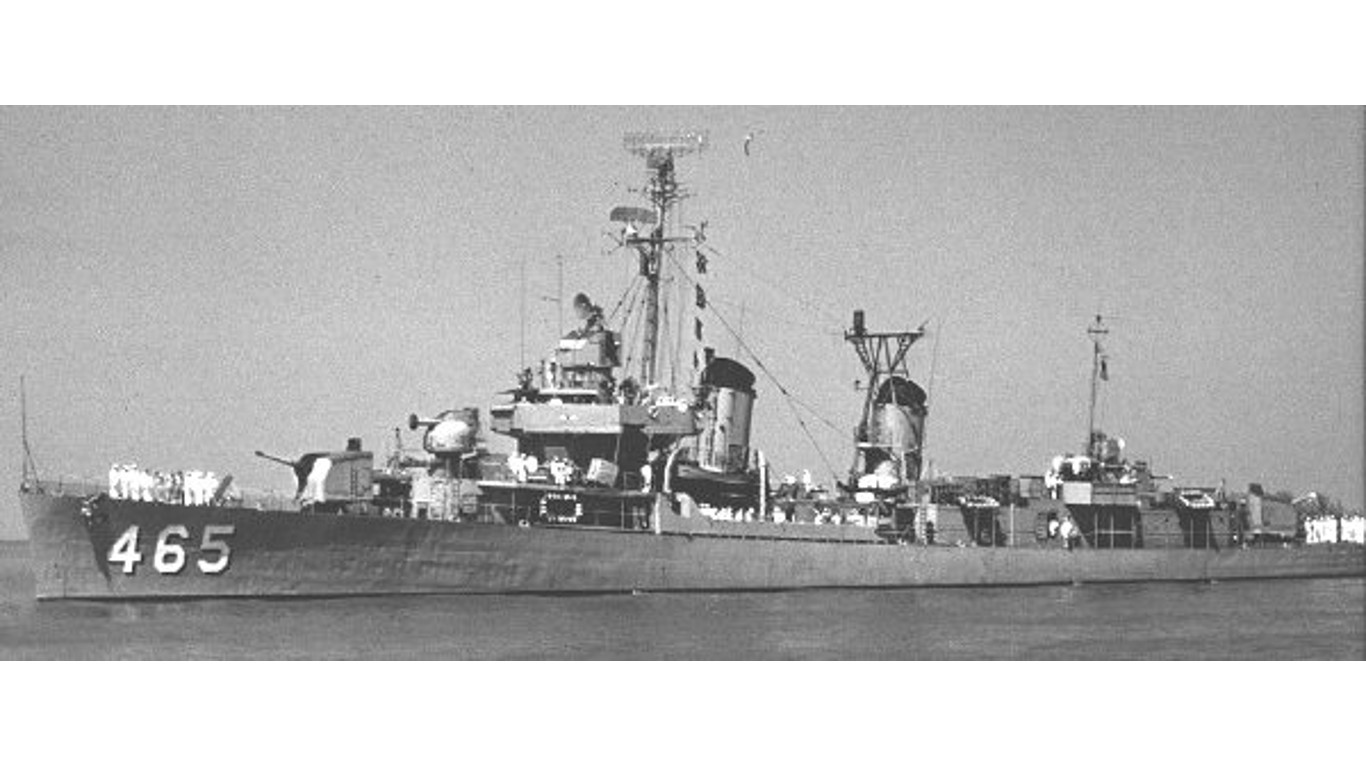
5. USS Saufley (DD-465)
> WWII battle stars: 16 (tied)
> Type: Destroyer
> Class: Fletcher-class
> Year entered service: 1942
> Personnel: 329
After participating in the Guadalcanal campaign, the USS Saufley undertook various missions, including escorting reinforcements, conducting antishipping sweeps, and providing shore bombardment. It played a crucial role at Guadalcanal and the occupation of the Russell Islands, transporting troops and supporting landing operations.
Saufley also engaged in escort and anti-submarine duties, sinking multiple enemy submarines. It took part in assaults on New Georgia, the Green Islands, and Guam, providing call fire support and screening services. After the war, Saufley served as an experimental ship, testing and evaluating sonar equipment and antisubmarine warfare weapons.
[in-text-ad]
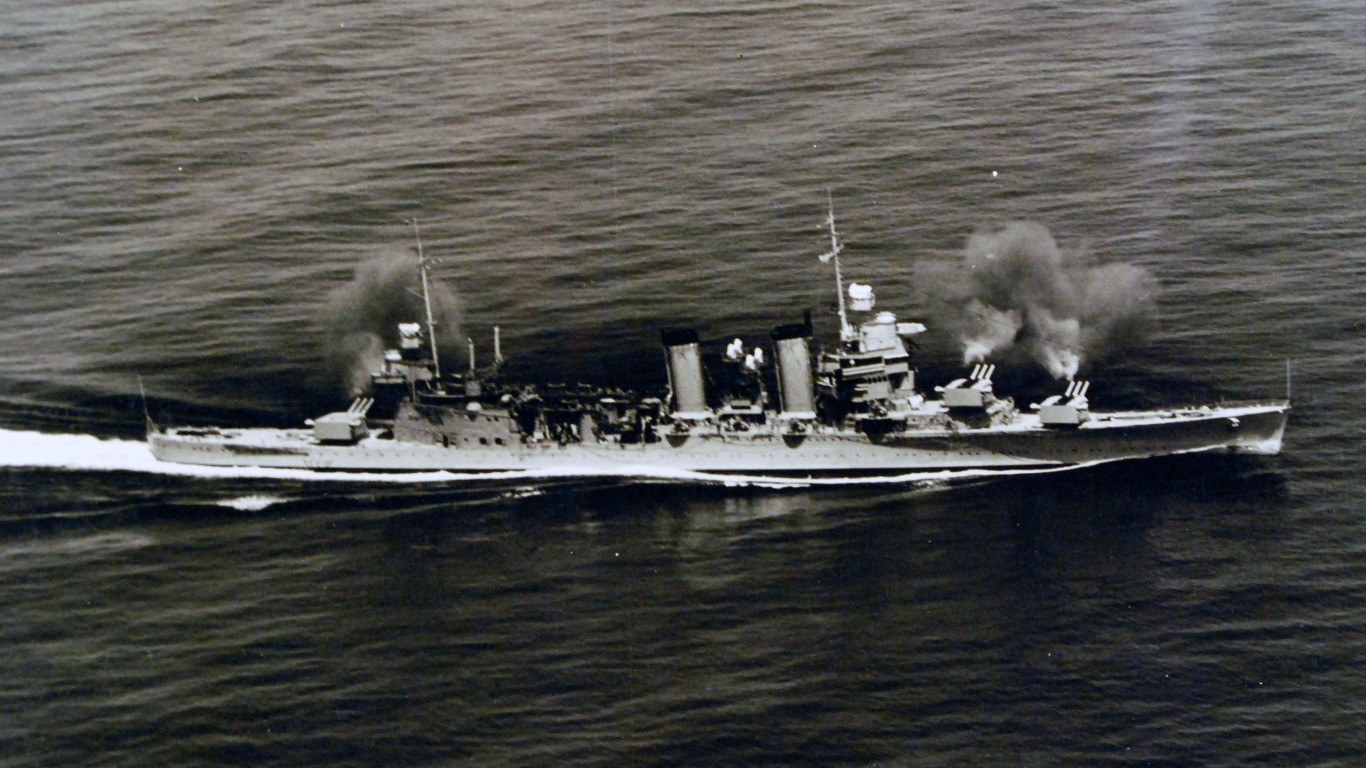
4. USS Minneapolis (CA-36)
> WWII battle stars: 17 (tied)
> Type: Heavy cruiser
> Class: New Orleans-class
> Year entered service: 1934
> Personnel: 708
The USS Minneapolis, a member of the New Orleans-class cruisers, served in numerous major battles in the Pacific Theater during World War II, earning the ship and its crews 17 battle stars. It operated in Europe and patrolled the American coast before being stationed at Pearl Harbor in 1940. During the Pearl Harbor attack, it was fortunately away for gunnery practice.
The Minneapolis played a crucial role in protecting the fleet carrier USS Lexington and participated in battles such as Coral Sea and Midway. It engaged in fierce combat, surviving two torpedo hits during the Battle of Tassafaronga. After undergoing repairs, the ship returned to action, taking part in various operations and battles until the end of the war. It was decommissioned in 1947 and ultimately sold for scrap in 1959.
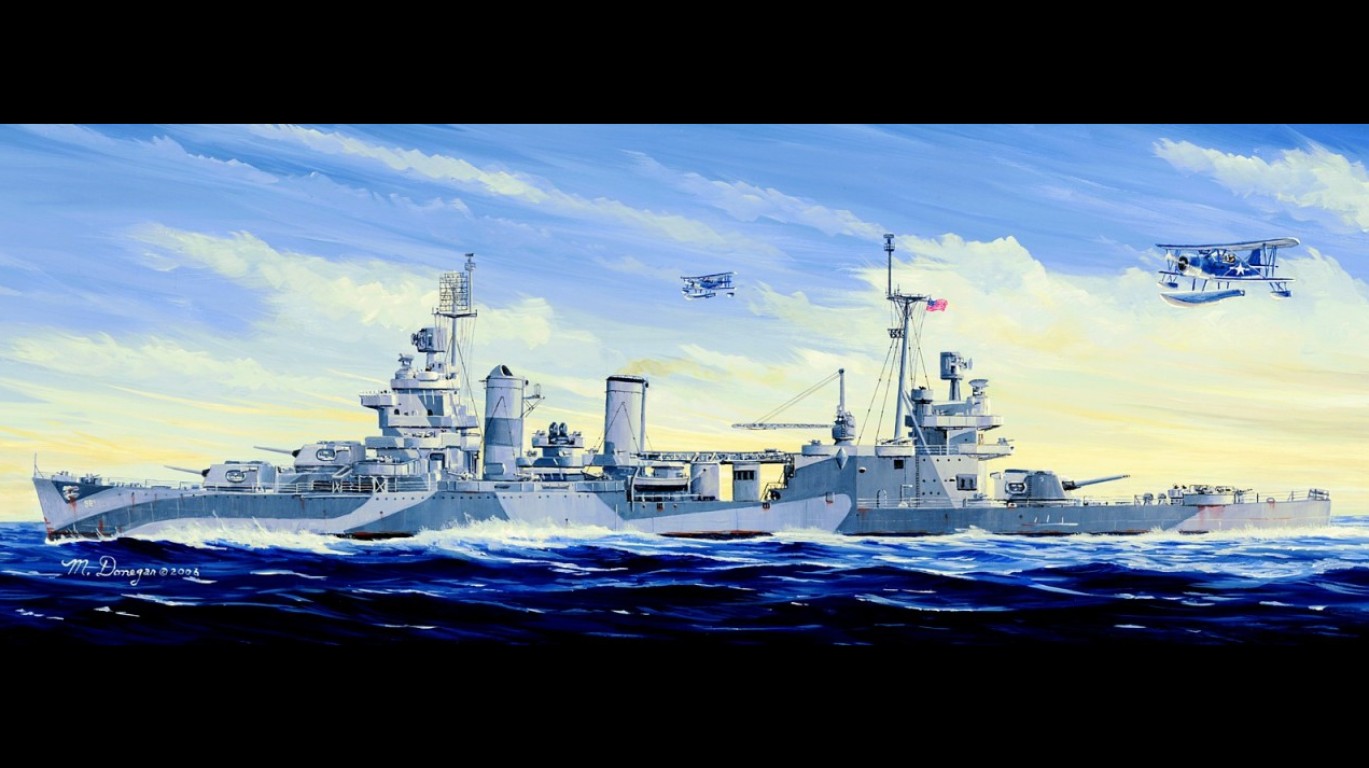
3. USS San Francisco (CA-38)
> WWII battle stars: 17 (tied)
> Type: Heavy cruiser
> Class: New Orleans-class
> Year entered service: 1934
> Personnel: 904
The USS San Francisco (CA-38), a heavy cruiser, began its wartime service in the Pacific, actively participating in anti-aircraft defense during the attack on Pearl Harbor. Despite being in the midst of an overhaul, the crew engaged in fierce gunfire against enemy aircraft.
San Francisco took part in various operations, including reinforcing Allied positions in the southern Pacific, carrier raids, and battles off Guadalcanal. The cruiser suffered severe damage from a crashing Japanese plane and gunfire during the Naval Battle of Guadalcanal. After undergoing repairs, San Francisco continued its service, escorting convoys and participating in the recovery of Attu and Kiska in the Aleutians. It played a role in numerous campaigns, including the Marshall Islands, Marianas, and Ryukyus. After the war, San Francisco operated off China and Korea before being decommissioned in 1946.
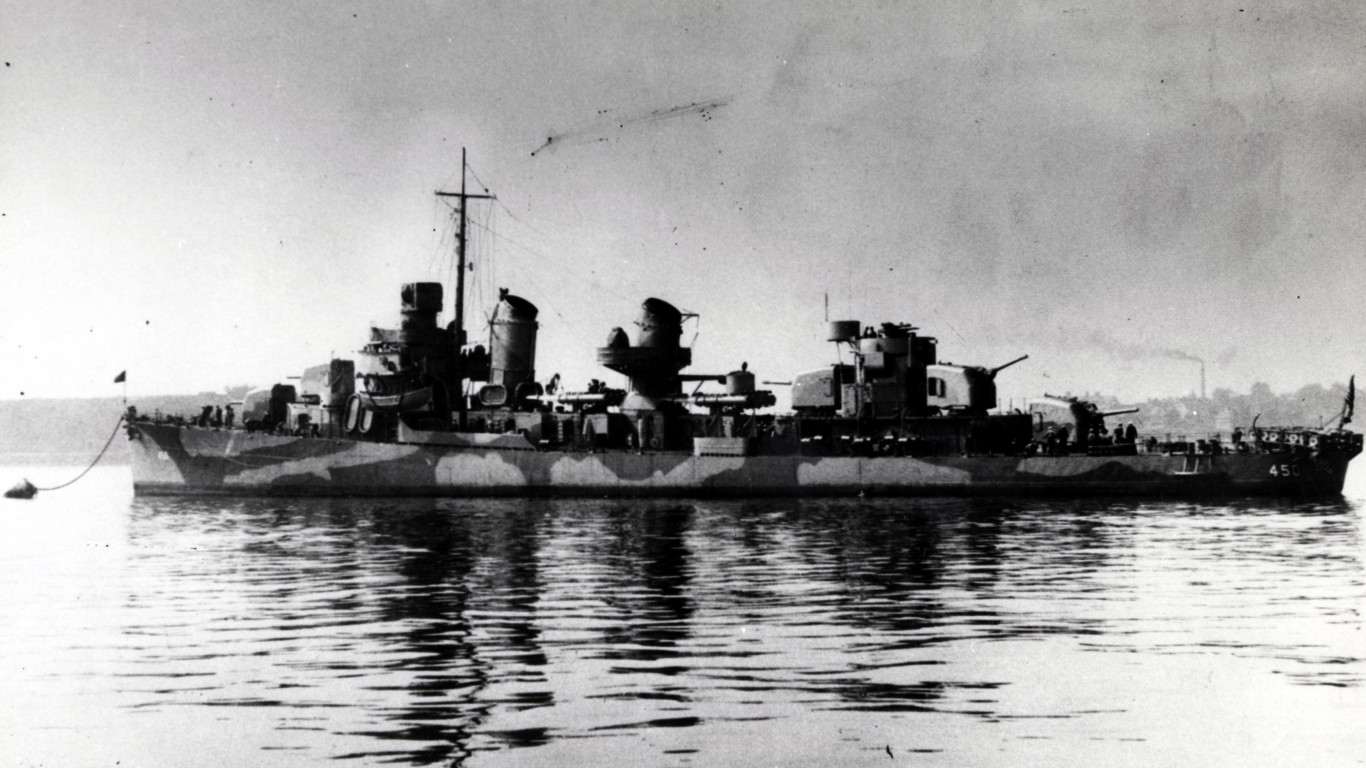
2. USS O’Bannon (DD-450)
> WWII battle stars: 17 (tied)
> Type: Destroyer
> Class: Fletcher-class
> Year entered service: 1942
> Personnel: 329
The USS O’Bannon (DD-450), a destroyer, played a vital role in World War II as one of the most decorated ships in the war. It joined the battle for Guadalcanal in the southwest Pacific, escorting ships and providing reinforcements to Henderson Field. During the Naval Battle of Guadalcanal, O’Bannon engaged the Japanese battleship Hiei, causing significant damage and leading to its eventual sinking by aircraft. The destroyer continued to protect landings, carry out escort duties, and participate in bombardments in the Solomons.
The ship was involved in the Battle of Vella Lavella, where it sank a Japanese destroyer and rescued survivors from damaged American vessels. The ship was decommissioned in 1970, having received the Presidential Unit Citation for its actions during the Guadalcanal campaign.
[in-text-ad-2]

1. USS Enterprise (CV-6)
> WWII battle stars: 20
> Type: Aircraft carrier
> Class: Yorktown-class
> Year entered service: 1938
> Personnel: 2,217
The USS Enterprise (CV-6), an aircraft carrier, is the most decorated American naval vessel to fight in World War II, playing a truly crucial role. During the war, Enterprise guns and planes shot down 911 enemy aircraft, sank 71 ships, and destroyed or damaged another 192. It played a vital role in the Doolittle Raids. During the Battle of Midway, the Enterprise’s aircraft inflicted critical damage on Japanese carriers. The ship also provided cover during the Guadalcanal landings and operated in the Battle of the Eastern Solomon Islands. The Enterprise’s participation led to the decisive defeat of Japanese naval air forces.
The ship participated in a number of subsequent battles, including the Battle of the Philippine Sea, Leyte Gulf and Okinawa, before undergoing repairs and concluding its active service. The Big E’s contributions and achievements solidified its status as a legendary warship of World War II.
Thank you for reading! Have some feedback for us?
Contact the 24/7 Wall St. editorial team.